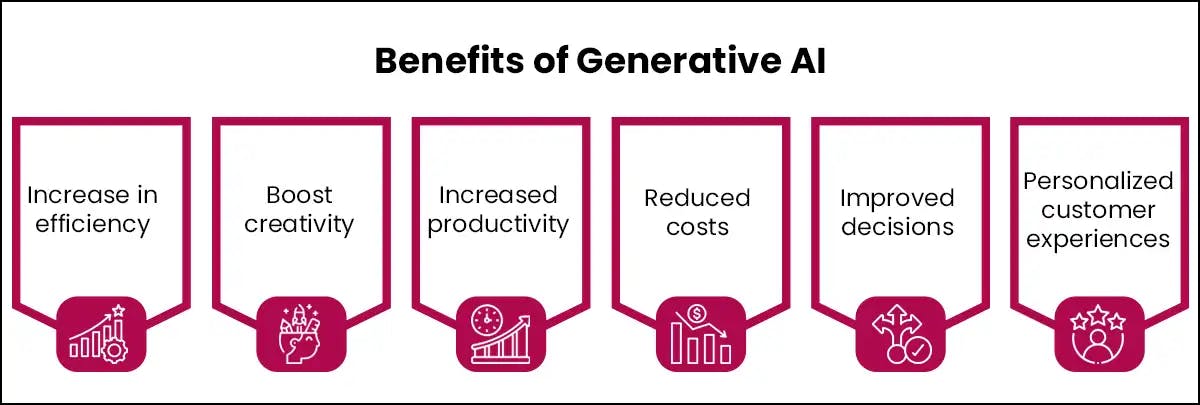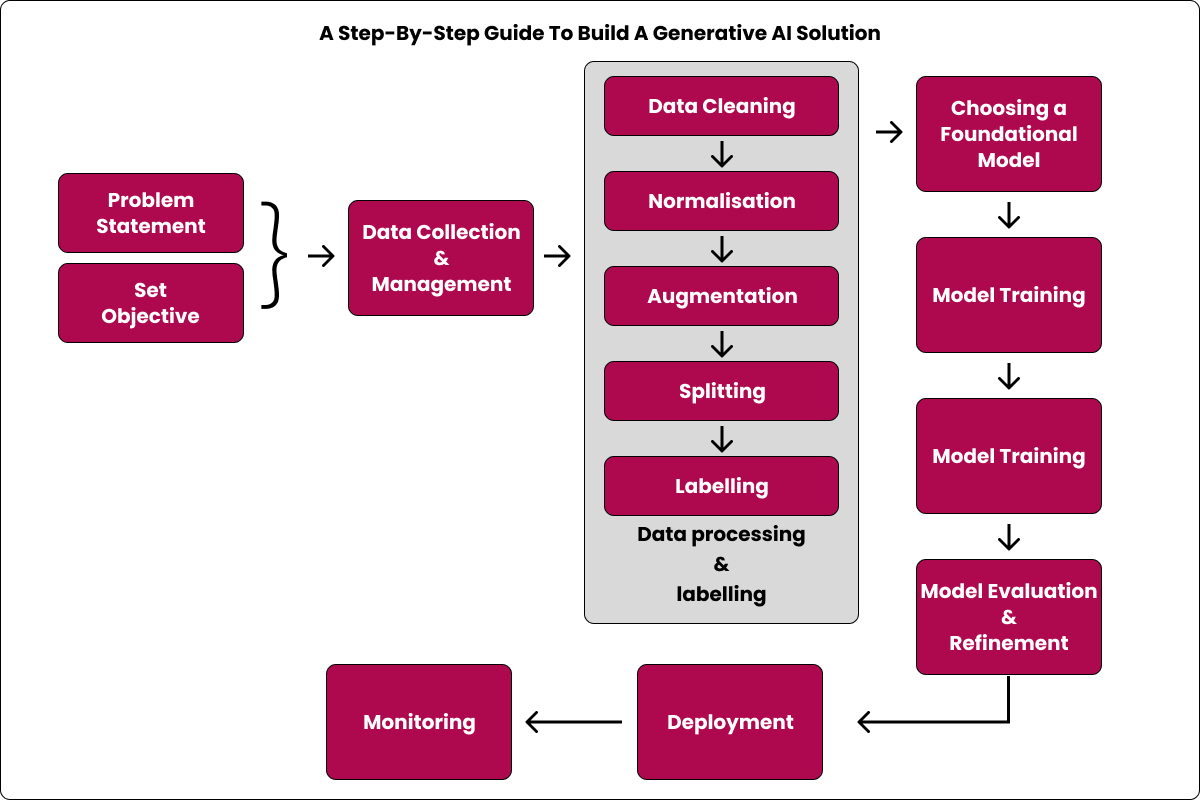
,
Artificial intelligence models focused on generation have experienced considerable development and increased scrutiny lately. Venture capitalists, lawmakers, and the general public are participating in dialogues surrounding advanced creations such as ChatGPT and Google Bard. Several startups in this sector have secured significant financial backing over the past year, mirroring this growing fascination. Generative artificial intelligence possesses tremendous capabilities to spark innovative remedies, establishing it as a crucial advantage for forward-thinking organizations.
So, it's no surprise that generative AI is making waves. Folks are excited about coming up with creative new solutions. This blog will give you a solid understanding of generative AI. Plus, we will walk you through the steps to build your very own generative AI systems.
A Brief on Generative AI
Generative AI is a kind of artificial intelligence that makes its unique content. It gets its clues from existing data like text, pictures, or sounds. This AI creation can help in many ways, like making art and music, writing stuff, boosting ads, increasing data, and even making data for areas with not enough real info. Several methods help generative AI, such as transformers, generative adversarial networks (GANs), and variational auto-encoders. Transformers like GPT-3, LaMDA, Wu-Dao, and ChatGPT are skilled at understanding and figuring out the importance of inputs. They're good at learn-to-make good texts or images. Generative AI models can look at a ton of data, see the patterns, and then make new, high-quality results.
Generative adversarial networks (GANs) are composed of two neural networks - a generator and a discriminator - that work in tandem to find balance. The generator creates new data and content that mimics real source data. Meanwhile, the discriminator tries to differentiate between the generated data and the source data, getting better at recognizing which more closely resembles the authentic information. This back-and-forth leads both networks to improve over time.
Variational auto-encoders utilise encoding to condense input into a coded form of representation. This code encapsulates the distribution of the input data in a less dimensionally extensive style. It is then used by the decoder part to recreate the original input. Reducing information into this compressed code, variational auto-encoders offer an effective yet powerful approach for generative AI to grasp data distributions in compact representations. The encoder-decoder arrangement aids generative models in reconstructing realistic outputs.
Benefits of Generative AI

- Increase in efficiency: Generative AI can make work more efficient.
- Boost creativity: It boosts creativity. Generative AI can come up with novel ideas people might not think of.
- Increased productivity: Generative AI enables enhanced business output by automating tasks.
- Reduced costs: Human performed tasks now automated by AI systems lead to cost savings at the initial stage.
- Improved decisions: Vast data analysis abilities allow more informed, strategic decision making.
- Personalized customer experiences: Generative AI facilitates tailored, customized engagements to enhance customer satisfaction.
A Step-By-Step Guide To Build A Generative AI Solution
Developing a generative AI system demands profound knowledge of the technology and the particular issue it seeks to address. It entails creating and coaching AI models to produce new outputs using input data. Several vital stages are necessary for assembling an effective generative AI solution: determining the problem, accumulating and pre-processing information, choosing suitable algorithms and models, honing and fine-tuning the models, and instituting the system in a real-life framework. Now, let's get deeper into this process.
Step 1: Defining the Problem and Setting Objectives
Building good generative AI starts with clearly defining the problem and desired outputs. Be it generating text, images, or sounds, being specific about needs is key to tackling unique challenges and collecting suitable data.
Details of target outputs then guide model complexity and data needs. For text, consider language and style constraints. For images, resolution, artistic styles like color schemes, etc. For music/sounds, audio formats, and genres.
With clear goals, explore technical approaches suited for the data - RNNs or Transformers for text, CNNs for images. Know model strengths and limits, like GPT-3's coherent short texts but not long passages, to set realistic expectations. Concrete metrics will eventually evaluate outcomes.

Step 2: Data Collection and Management
Good AI needs lots of high-quality, ethically obtained data. Data sources should have diverse, relevant examples like the AI's intended uses. For images, varied captures from different angles, lighting, and backgrounds are best. For text, diversity of language is key.
Preparing the data is also crucial. Cleaning removes errors and inconsistencies. Normalisation and augmentation make models more flexible. Extracting key features boosts efficiency. Splitting data into training, validation, and testing sets prevents overfitting. Labelling assists supervision by categorising examples manually.
A thoughtful data preparation process ensures clean, robust datasets that optimally empower model creation. Continued data versions enable improvement as tasks and data change over time. A balanced approach considers both technical needs and ethics for responsible AI.
Step 3: Data processing and labelling
Once data is collected, it must be prepared and enriched before it can be used for training AI models. This involves cleaning, normalising, augmenting, and labelling the data:
- Data cleaning
Raw data contains errors, outliers, and inconsistencies. These must be identified and removed using tools like pandas. For text, this may involve fixing spelling, removing special characters, etc. - Normalisation
Data should be normalised to a common scale so features are fairly weighted. Techniques like min-max scaling and z-score normalisation are commonly used. - Augmentation
The dataset is artificially expanded through transformations like rotations, synonyms, etc. This makes models more robust and prevents overfitting. - Splitting
The dataset is divided into training, validation, and test sets for proper model development. - Labelling
Data is manually annotated with categories or answers for supervised learning.
Careful data processing and enrichment results in clean, robust datasets that can effectively train AI models.
Step 4: Choosing a Foundational Model
Pre-trained models like GPT, LLaMA, and Palm give AI generators a strong starting point. This saves time and computing power compared to training from scratch. Their massive data exposure lets them learn general patterns and knowledge.
Pick foundations that match your goal. GPT is good for text like chatbots because its transformer design handles paragraph coherence well. LLaMA enables multilingual output. Palm's strengths depend on its evolving skills.
Also consider available data, infrastructure limits, how flexible the model is for customization, and community support. These impact how easily you can tailor the foundation later.
Building on top of robust general foundations by fine-tuning them for your particular dataset and needs efficiently creates custom AI generators. Choose bases that technically fit your architecture and use case. Ensure you have the resources to fully leverage their capabilities.
Step 5: Model Training And Fine-Tuning
Generative AI involves feeding prepared data to models using neural networks and deep learning for pattern identification and emulation. Once a foundational model is adequately trained, fine-tuning becomes imperative. This refines the model for specific tasks or domains—for example, generating poetry by training on poetic text.
Fine-tuning entails adjusting the model's weights using particular datasets to align outputs more closely with desired outcomes. Techniques like differential learning rates (training different layers at different rates) help. Tools like Hugging Face's Transformers library simplify fine-tuning many foundation models.
Step 6: Model Evaluation and Refinement
After training, evaluating model efficacy by quantifying output similarities to actual data is imperative. However, evaluation alone is insufficient; refinement through continuous adjustments for improving accuracy, reducing inconsistencies, and enhancing quality is pivotal.
While evaluation provides performance snapshots, relentless refinement ensures continued relevance, robustness, and efficacy despite evolving environments, data, and requirements.
Step 7: Deployment and Monitoring
When ready, models require thoughtful deployment guided by transparency, fairness, and accountability ethics. Continuous monitoring afterward remains imperative—regular checks, feedback collection, and metrics analysis ensure lasting efficiency, accuracy, and ethical soundness across scenarios.
Deployment
- Infrastructure Setup
Hardware selections fit model complexity—large models may need GPU/TPUs. Cloud platforms like AWS SageMaker facilitate deployment scaling/management. - API Integration
FastAPI, Flask, and similar frameworks enable easy model API access for applications and services. - Ethical Considerations
Anonymization of inputs/outputs preserves privacy. Pre-deployment bias checks are compulsory, as is ensuring no discrimination against user groups. - Transparency and Accountability
Capabilities, limitations, and expected behaviors require clear documentation. User question/concern channels also prove beneficial.
Monitoring
- Performance Metrics: Tools track real-time latency, throughput, errors, etc. Alarms trigger for anomalies.
- Feedback Loops: User output feedback mechanisms identify issues and improvements.
- Drift Detection: TensorFlow Data Validation and similar track data drift over time requiring retraining.
- Ethical Monitoring: Systems that catch unintended consequences or harms enable continuous ethical policy updates.
- Security: Checks for infrastructure vulnerabilities and data encryption are mandatory, as are authentication mechanisms and security best practices.
Deployment transitions models to complex real-world contexts. Monitoring keeps them functionally and ethically sound over time—a joint path of technology and ethics for responsible AI.
Curious about the magic behind Generative AI?
Generative AI Tech Stack
This section explores the key components, algorithms, and frameworks underlying generative AI systems.
Application Frameworks
Application frameworks rationalise and incorporate new advancements to modernize generative AI adoption. Popular options like LangChain, Fixie, Microsoft's Semantic Kernel, and Google Cloud's Vertex AI simplify creating and updating apps that:
- Produce original content
- Enable natural language search
- Perform autonomous tasks
These frameworks are changing how we work. They make it easier for developers to add generative AI to apps. This translates new research into real-world solutions.
As generative AI advances quickly, good frameworks help integrate it with existing tech. They will be key for businesses using generative AI in different industries.
Models
Foundation Models (FMs) are the intelligent core of the system, capable of human-like reasoning. Developers can choose from various pre-trained FMs based on factors like output quality, supported modalities, context size, cost, and latency. Leading options include proprietary models from vendors like Anthropic and Cohere, popular open-source models, or developers can train their custom models.
Data
Large language models can only understand things from their training data. Developers can feed them more data to make them smarter. They can add structured data like databases. They can also add unstructured data. Vector databases help store and access the vector representations used by these models. Relevant data can be included in prompts with retrieval-augmented generation. This makes the outputs more personalised without extra training. So the models can give customised results at large scale. Adding more data makes them better at specific tasks.
Evaluation Platform
Developers need to balance tradeoffs between accuracy, cost, and speed. They can improve performance by iteratively refining prompts, fine-tuning models, and testing different vendor options. Evaluation tools help with prompt engineering, tracking experiments, and monitoring live systems. Developers can get the best accuracy at an affordable cost and speed by carefully optimising.
Deployment
Once generative AI applications are ready for production, AI developers have deployment options. They can choose self-hosting and frameworks like Gradio to get more customization and control. Turnkey services like Fixie allow teams to seamlessly build, share, and deploy AI agents without infrastructure burdens. With the complete generative AI stack transforming how we create and process information, flexible deployment options help developers. They let developers focus on innovation while still ensuring reliability, scalability, and proper governance. The right deployment strategies make it easier to get generative AI applications live so they can start delivering value.
Generative AI applications
Generative AI can have a major impact in many creative and technical fields. This modern technology can assist with tasks like programming, writing, visual arts, and other design work.
- Graphics
Generative graphics use advanced AI to convert unique creatives into images. They give you the capability to render any picture in the style of historic artists with striking authenticity. The technology even goes beyond mimicking existing art by conjuring completely new patterns, figures, and details not present in the original image. With generative graphics, your imagination and innovation know no bounds. Any idea you dream up can be transformed from a crude sketch into a stunning fully formed image. - Photos
AI empowers your photos like never before. Advanced algorithms detect and correct flaws, filling in missing or obscured visual details for stunningly enhanced, realistic images. They can also upscale lower-resolution shots into crystal-clear masterpieces with striking professional quality. - Audio
Generative AI audio technology brings a new level of humanity and creativity. Modern algorithms can transform computerized speech into natural, human-like voices - mimicking the fluid intricacy of actual human vocalisation. Text-to-speech functionality also reaches new heights of conversational flow and warmth. For all audio content creation, from podcasts to audiobooks, generative AI ensures your words resonate with authenticity. The same technology empowers musical creativity, helping human composers achieve works with truly emotional soul and expressiveness. - Video
Generative AI lets filmmakers bring their creative ideas to life. Directors can use it to adjust lighting, style, and other effects in each frame. This helps them achieve the cinematic look they want. Scenes can be made more dramatic or beautiful in ways not possible before. Whatever directors imagine, generative video can turn raw creativity into cinematic excellence. - Text
Generative AI lets you create content at an unprecedented pace without compromising quality. No matter whether you need rapid high-volume content or one-of-a-kind stylistic pieces, generative text capabilities help you produce material that consumes and delights your audience. - Coding
Generative AI supercharges coding with unprecedented speed and customization. Now you can automatically generate full builds of application code tailored to your exact specifications and use cases. Additionally, new breeds of AI can analyse existing codebases to produce new functional scripting based on accrued knowledge - taking cues from prior programs to churn out novel iterations. With these futuristic tools, generating and enhancing code happens in a fraction of the time, unleashing a new age of efficiency.
Conclusion
Generative AI offers exciting opportunities. Many forward-thinking companies are using their robust power to establish, service, and monitor complex systems with ease. This advanced AI technology helps organisations boost automation and remain adaptable in this fast-moving world.
As we bring the advancements of generative AI, we uncover its value in a wider range of areas using advanced AI technologies. It delivers amazing advantages with its domain-specific generative AI models and solutions. We're only seeing the start of more opportunities. Generative AI equips enterprises with an edge, providing unmatched innovation, efficiency, speed, and precision.
Generative AI brings many advantages and big wins for business. Big companies that use AI place themselves at the top. There is no limit to what we can do with AI in creating new things and growing.
Want to implement Generative AI and large language model software services in your business? Our Generative AI specialists at Codiste are ready to help with your project needs. Codiste's AI developers have expertise in developing models that improve decision-making, optimise cost, and so forth.
Let's connect with Codiste for expert advice on what's coming and guide the way.




